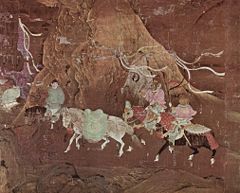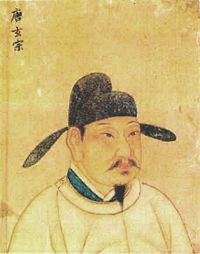Emperor Xuanzong of Tang China
- This article is about the well-known seventh emperor of Tang Dynasty. For his descendant whose temple name is also rendered Xuanzong in pinyin, see Emperor Xuānzong of Tang.
| Emperor Xuanzong of Tang China | |
|---|---|
| Birth and death: | 8 September, 685–May 3, 762 |
| Family name: | Lǐ (李) |
| Given name: | Longji (隆基) |
| Dates of reign: | 8 September, 712¹–12 August, 756² |
| Temple name: | Xuánzōng (玄宗) |
| Posthumous name: |
Emperor Ming³ (明皇) |
| Posthumous name: |
Emperor Zhidao Dasheng Daming Xiao |
| General note: Dates given here are in the Julian calendar. They are not in the proleptic Gregorian calendar. | |
Emperor Tang Xuanzong (Chinese: 唐玄宗) (September 8, 685 - May 3, 762), born Li Longji (李隆基), was the sixth emperor of the Tang dynasty in China, reigning from 712 to 756. His reign was the longest during the Tang Dynasty, and he was credited with bringing Tang Dynasty China to a pinnacle of culture and power. His later reign was affected by the influence of Yang Guifei, one of his consorts, and was ultimately terminated by a great and disastrous military rebellion.
Accession to the throne
Born into an era when power was virtually in the hands of his grandmother, the Empress Wu Zetian, Xuanzong became the only glimmer of hope for the restoration of the imperial Li family. His aunt, the Princess Taiping fiercely protected Xuanzong from harm and was credited with taking care of young Xuanzong from the Wu family. In 710 Xuanzong conspired with Princess Taiping (daughter of Empress Wu Zetian) to put an end to Empress Wei's attempted usurpation of power. He killed Empress Wei, the wife of his recently dead uncle Emperor Zhongzong, in a palace coup which placed his own father, Emperor Ruizong, on the throne. He was appointed as Chancellor for a few months before he became the crown prince. Xuanzong then succeeded to the throne in 712.
Kaiyuan era
Known also as Tang Minghuang (唐明皇: "the understanding emperor of the Tang"), he began the early half of his reign (712-730's) by raising Tang China to the height of its powers, in a period known popularly as the Kaiyuan era (開元之治). Initially, Xuanzong was a hardworking and diligent emperor.
At the beginning of his reign, many of the vassals originally controlled during the Taizong and early Gaozong's reign had rebelled during Wu Zetian's later reign. These included Khitans (the ancestors of the later Liao dynasty), Korea, the Western and the Eastern Turks (practically all of North Asia and Mongolia), and the Uyghurs, all of whom rose in rebellion. In general, Xuanzong was only left with the central part of China as his Empire. Furthermore, the Silk Road was closed off and corruption along it was noticeable (since Wu Zetian's time). Over all, Xuanzong was left with a big mess from Wu Zetian's later reign.
Luckily, Xuanzong was diligent and wise enough as a leader. The Tang Army was able to defeat the Khitans, Uyghurs, Tibetans, and Western Turks (although only the latter's land was conquered, while the other three still continued to resist). Notably, the Tang were defeated by the Eastern Turks during the 720s. However, though Tang lost those battles, the Eastern Turks soon dissolved in internal conflict, so the Tang did not have to do anything. During Xuanzong's reign, the maximum extent of territory included a slightly expanded heartland China, plus the land originally held by the Western Turks all the way to the border of Persia, and a tiny section of land connecting the former Western Turk lands to the heartland; however, this was enough to reopen the Silk Road for economic trade. As to the economy, Xuanzong was able to clean out the corrupt officials left by Wu Zetian. During the Kaiyuan period, Xuanzong installed competent officials (such as Zhang Jiuling as prime minister) who helped the country grow economically.
He made sweeping reforms to the bureaucracy, employed capable ministers, had contact with foreign ambassadors as far west as the Middle East, and greatly expanded China's borders to the borders of the Ummayad Empire and later the Abbasid Caliphate. The maximum extent of the empire controlled the Pamirs and Kashmir.
In general, the Tang kept up good relations with Korea though they were not vassals. This period witnessed the nurturing of a cooperative relationship with the Unified Silla state on the Korean peninsula, then under the rule of King Seongdeok. Xuanzong saw in Silla a valuable ally on its flank, particularly against the growing power of the state of Bohai (Balhae), which in 733 had actually launched a seaborne attack on Dengzhou in Shandong. Tang Xuanzong decided that it would be wiser to make Unified Silla as an ally rather than vassal because the Tang army was having it's own war in the Northern and Western front with the nomadic people and Tibetans.
Xuanzong also made progress on the empire's financial system by effectively registering the whole population, resulting in higher tax revenues. He also repaired the Grand Canal system, which has fallen into disrepair during Wu Zetian's reign.
Since the Fu Bing military system was considerably declined starting from the 670s (when the vassals started rebelling), Xuanzong decided on the Jie Du Shi system where military leaders would control their own soldiers. While this system seemed to be the solution at first as it was successful, it created two problems. One was the control of the military outside the emperor's hand and two was the military expense that doubled to tripled from before.
Other areas, such as Chinese arts and literature, also reached a zenith during his reign, with famous poets such as Li Bai, Du Fu and Meng Haoran, who created some of the most elegant poems since the Han dynasty.
The emperor became famous, amongst other things, as a patron of the arts and for his notorious love affair with Yang Guifei. She was the young wife of his son Prince Shou (壽王), but he decreed their divorce and then entered her into a Taoist nunnery for a couple of years so that he could take her as his palace consort without shame. He rebuilt the ancient hot springs palace at the foot of Lishan Mountain for his consort and her sisters, naming it Huaqing Palace.
Later years (mostly the Tian Bao Era)

As Xuanzong turned his attention to pleasure-seeking with Yang and her family, he paid less and less attention to the running of his empire, and much of his power fell into the hands of court officials like the corrupt but competent Li Linfu (who was succeeded by Lady Yang's dissolute cousin Yang Guozhong) and the influential court eunuch Gao Lishi.
During one time, when Xuanzong asked Li Linfu to find more intelligent officials to work for the government, Li Linfu went out and look. When Li Linfu came back, he said that there are no more talents out there and that the emperor has already taken in all the talent the country has to offer. Tang Xuanzong believing in his brilliance thought Li Linfu was correct. A similar scenario happened to Tang Taizong in the late 620s. When Tang Taizong asked Feng Diyi to find talents, Fend Diyi gave a response similar to Li Linfu; however, contrary to Xuanzong, Taizong believed Feng Diyi didn't look hard enough and said that it was the government's responsibility to find the talented people.
At the same time, 751 saw the loss of the critical Battle of Talas against the Arab Abbasid Empire. As a consequence, the Tang lost some of its influence in Central Asia to the emerging Abbasid Caliphate. In general, the country started to decline after this major turning point battle.
Meanwhile, Jie Du Shi (generals) of the outlying provinces, many of which had been recently reconquered, took more and more regional power into their own hands. Some successful generals include Geshu Han who normally defeated the Tibets, Gao Xianzhi would conquered to the borders of Persia, and An Lu Shan who defeated and once again vassalized the Khitans. During the early part of Xuanzong's reign, most Jie Du Shi were of Han ethnic, but when Li Linfu took over, he installed foreign Jie Du Shi like An Lu Shan. This was because Jie Du Shi could potentially challenge the prime minister's position in the future when generals decide to politically work for the government. Since people of foreign ethnic is less likely to get a large official position in the government, Li Linfu wouldn't have to worry about future generals going against him. Eventually, a Turkish/Sogdian named An Lushan started the An Lushan Rebellion in Fanyang in 755. The rebels quickly captured the city of Luoyang, and then the imperial capital Chang'an six months later.
Xuanzong fled to Sichuan during the war, and Yang Guifei and Yang Guozhong, who attempted to flee with him, were killed by the Imperial bodyguard for their perceived part in the Emperor's weakness and loss of control.
Abdication and death
Xuanzong abdicated his position to Suzong, the heir apparent, in 756. He was put under house arrest in 760 in his own palace by his son and Li Fuguo. Still mourning for his lost Lady Yang, he died in 762 shortly before the rebellion was finally quashed. His rule was the longest of the Tang dynasty, lasting nearly 44 years.
He was deeply criticized by later historians, even during his own Tang Dynasty, for corruption and his appointment of Li Linfu to the chancellorship. On the other side, Mao Zedong said that Xuanzong was "half bright, half dark"(一半明一半暗). The strength that Xuanzong had allowed the warlords in the border provinces (Fanzhen) led to a period of increasing conflict and instability which set the stage for the end of the Tang Dynasty and the ensuing Five Dynasties and Ten Kingdoms Period.
See also
- minister Zhang Jiuling
- artist Wu Tao-Tzu
- royalty Princess Taiping
| Preceded by: Li Jiao |
Chancellor of China 710 |
Succeeded by: Song Jing |
| Preceded by: Emperor Ruizong |
Emperor of Tang 712–756 |
Succeeded by: Emperor Suzong |
de:Tang Xuanzong fr:Tang Xuanzong ko:당 현종 it:Xuan Zong (imperatore Tang) ja:玄宗 (唐) no:Keiser Xuanzong av Tang zh:唐玄宗
Credits
New World Encyclopedia writers and editors rewrote and completed the Wikipedia article in accordance with New World Encyclopedia standards. This article abides by terms of the Creative Commons CC-by-sa 3.0 License (CC-by-sa), which may be used and disseminated with proper attribution. Credit is due under the terms of this license that can reference both the New World Encyclopedia contributors and the selfless volunteer contributors of the Wikimedia Foundation. To cite this article click here for a list of acceptable citing formats.The history of earlier contributions by wikipedians is accessible to researchers here:
The history of this article since it was imported to New World Encyclopedia:
Note: Some restrictions may apply to use of individual images which are separately licensed.
